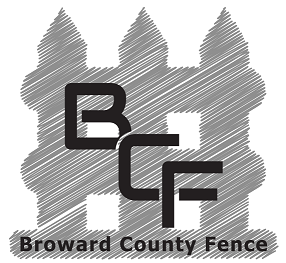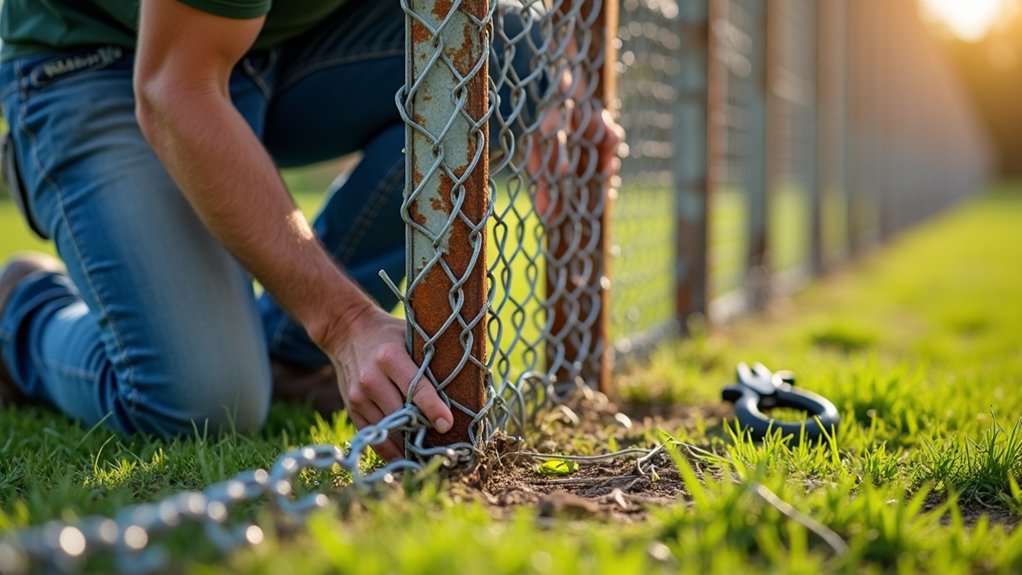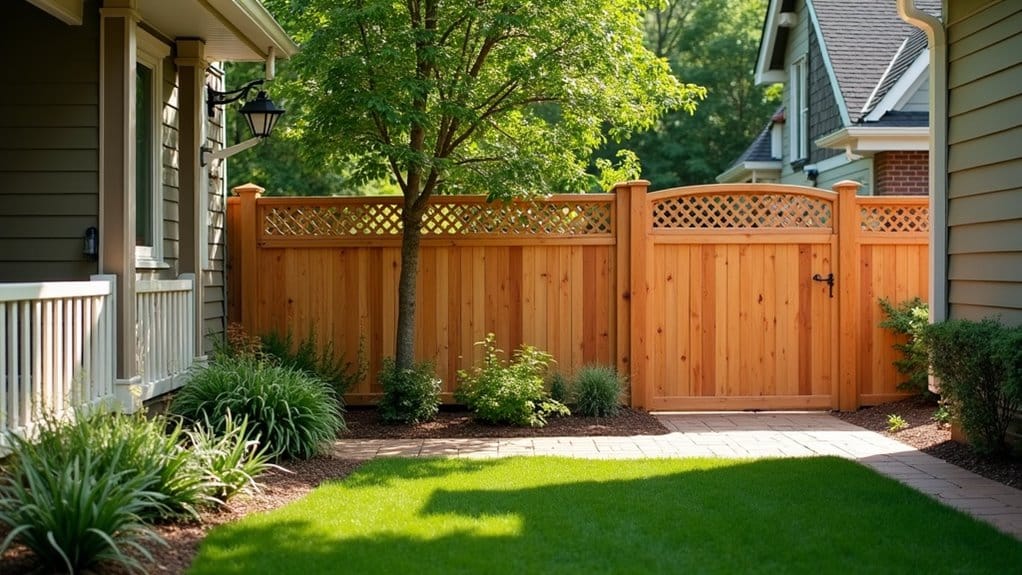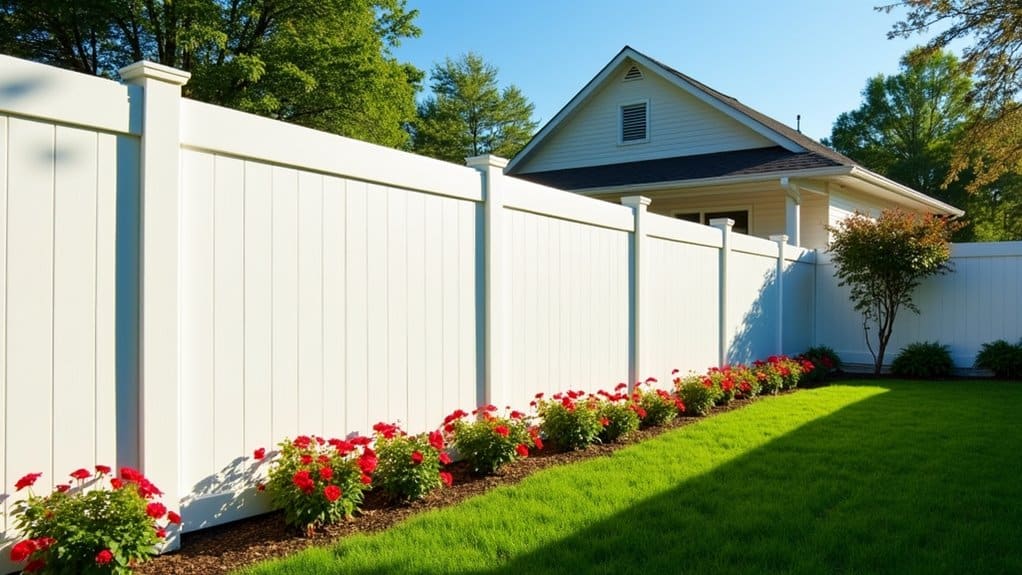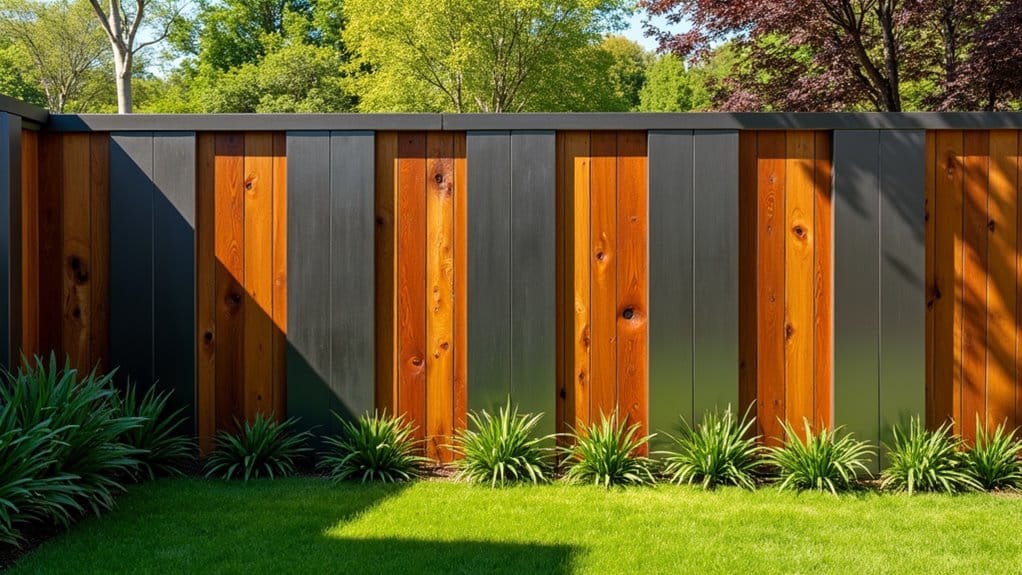To repair chain link fencing with new fabric or wire, first assess the damage and mark the affected areas. Release the tension and cut out the damaged sections. Install the new fabric tightly for security. Opt for durable materials like galvanized steel or vinyl-coated wire for better weather resistance. Regular maintenance, such as cleaning and rust prevention, can extend the life of your fence. For more information on materials and tools needed, check out the following sections.
Key Takeaways
- Start by marking the damaged areas of your chain link fence for a precise repair.
- Release tension by removing bolts from the tension bars and disconnecting the fabric from the top rail.
- Use wire cutters to remove the damaged section, ensuring your workspace is clean and free of debris.
- Measure the gap for the new fabric, cut it slightly larger, and attach it securely with tension bars.
- Regularly check and maintain your fence to avoid future damage and prolong its lifespan.
Assessing Damage and Preparing for Repair

Before fixing your chain link fence, it’s important to evaluate the damage. Check for rust, loose fabric, and bent posts. Look for broken ties and missing sections, and take note of what you find. Consider what caused the damage, like bad weather or vandalism, to prevent future issues. Chain link fencing is often resistant to damage from pests and weather conditions, making it a durable option.
To prepare for repairs, clear away any plants and debris around the fence for easy access. Use a wire brush to remove rust, and gather tools like wire cutters and pliers. Regular inspections help identify problems early, which can save time and money in repairs. Clearly mark each section that needs repair for accurate cutting and installation. This organized approach will make your repairs easier and help your fence last longer.
Selecting the Right Materials for Replacement

When replacing your chain link fencing, consider these key factors to make the best choice:
- Durability: Choose galvanized or stainless steel for strong, long-lasting options. Chain link fences are known for their cost-effectiveness as they provide reliable security without breaking your budget.
- Appearance: If aesthetics matter, vinyl-coated steel comes in various colors to enhance your yard. Customizable designs can help align the fence with your property’s decor, adding to its visual appeal.
- Cost: Keep your budget in mind; while vinyl-coated options may be pricier, they resist corrosion better. Additionally, tension wire is crucial for maintaining the fence’s integrity and preventing sagging.
- Maintenance: Aluminum and stainless steel require less upkeep than galvanized steel. Chain link fences are largely maintenance-free, allowing you to focus on other aspects of your property.
- Weather Resistance: Pick materials that can handle your local climate effectively. Selecting the right materials will ensure your fence remains functional and visually appealing for years to come.
Step-by-Step Guide to Repairing Chain Link Fabric
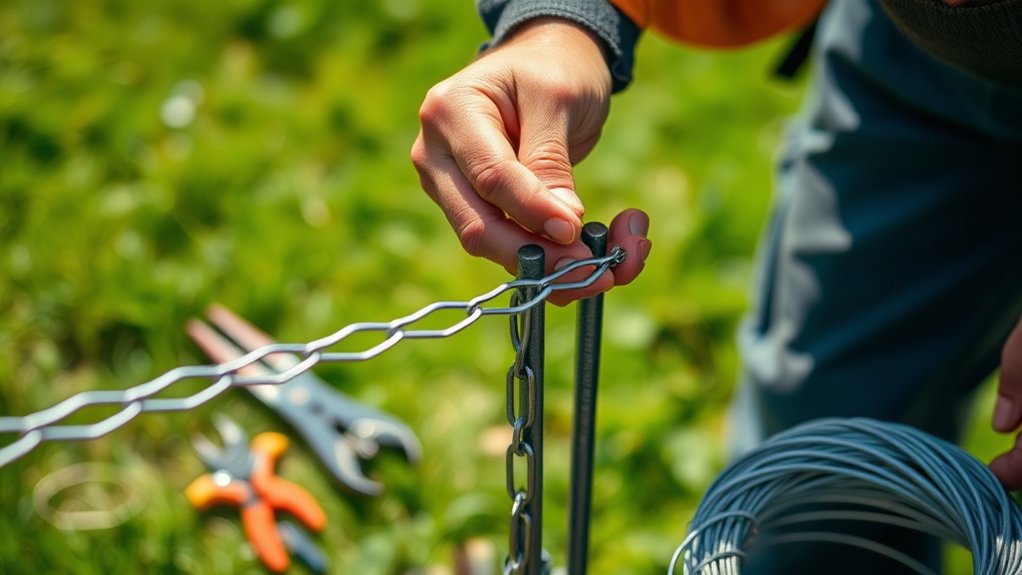
To repair chain link fabric, start by identifying and marking the damaged areas.
Release tension by removing the bolts from the tension bars and disconnecting the fabric from the top rail. Clear away any debris. It’s essential to regularly clean your fence to prevent rust and prolong its lifespan. Additionally, ensure you have the right post hole digger for any necessary adjustments during repairs.
Use wire cutters to remove the damaged section, ensuring you have clear boundaries. With pliers, take out any leftover wires.
Measure the gap for the new fabric, cut it slightly larger, and ensure it matches the existing fabric type.
Hang the new fabric loosely, weave it into the existing sections, and secure it tightly.
Finally, reinsert the tension bars and double-check that everything aligns properly and is secure.
Replacing Entire Sections of Chain Link Fence

Replacing a section of chain link fence is straightforward if you follow these steps:
- Assess the Damage: Determine the length and location of the damaged section.
- Measure: Get the dimensions of the panel and the distance between posts.
- Gather Tools: You’ll need pliers, c-clamps, wire ties, and new fabric.
- Check Posts: Ensure the existing posts are sturdy and intact.
- Clear the Area: Remove any obstacles that may get in the way.
After preparing, remove the damaged section and install the new fabric, ensuring it’s properly tensioned.
Regularly check the fence to keep it secure and looking good.
Maintenance Tips to Prevent Future Damage
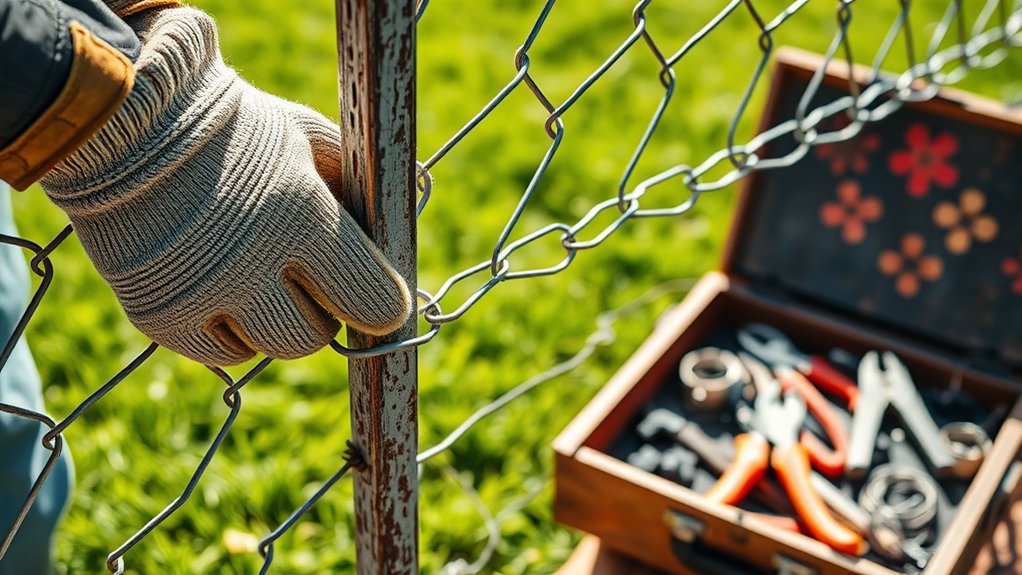
To keep your chain link fence in good shape and prevent damage, perform regular inspections to catch any wear early.
Clean your fence once a year to remove dirt that can cause rust. If you spot rust, use a chemical remover, then apply metal primer and finish with paint for extra protection.
Lubricate hinges to keep them working smoothly, and check screws and bolts, tightening any that are loose to maintain strength.
Trim back any plants around the fence to avoid damage from roots or branches.
Finally, ensure the area is clear for easy access during maintenance. Address issues right away to stop them from getting worse.
Frequently Asked Questions
How Long Does Chain Link Fabric Typically Last?
Chain link fabric usually lasts between 15 to 30 years, depending on factors like climate and exposure to the elements. To ensure it lasts longer, opt for galvanized or vinyl-coated materials and perform regular maintenance.
Can I Use Any Type of Wire for Repairs?
Not all wires are suitable for repairs. Make sure the wire you choose matches your existing materials. Use the correct repair methods and wire gauge to ensure your fence remains strong and durable. This prevents future issues and keeps your fencing intact.
What Tools Are Needed for a DIY Repair?
For DIY repairs, essential tools include bolt cutters, pliers, and a come-along tool. Using these tools effectively will help you maintain the strength and functionality of your fence.
How Often Should I Inspect My Chain Link Fence?
Inspect your chain link fence at least once a year to keep it in good shape. Regular check-ups help you spot any problems early, preventing bigger issues down the line. Think of it like getting a yearly health check-up for your fence—better safe than sorry!
Is It Necessary to Paint Chain Link Fences?
Painting chain link fences isn’t required, but it offers several benefits. It can make your fence look better, protect against rust and corrosion, and extend its lifespan. Plus, a freshly painted fence can enhance your property’s curb appeal.
Conclusion
Repairing chain link fencing goes beyond just replacing damaged fabric; it’s crucial for your property’s security and appearance. By assessing the damage and using the right materials, you can restore function and extend the fence’s life. Regular maintenance helps prevent future problems. Think of these repairs as an investment in your home’s value and security, ensuring your fence remains strong against wear and weather.
